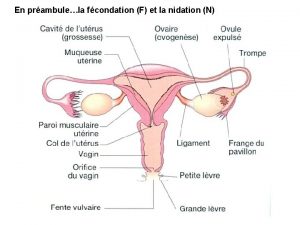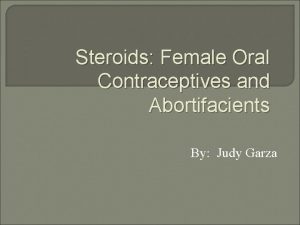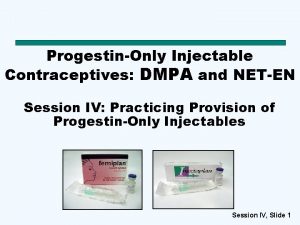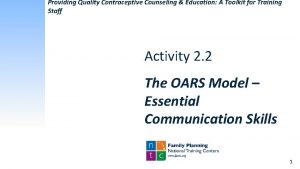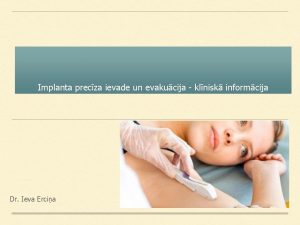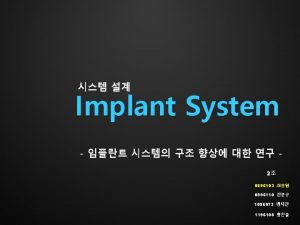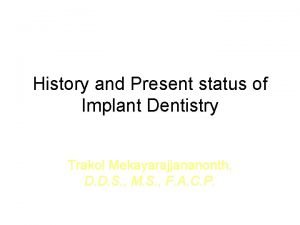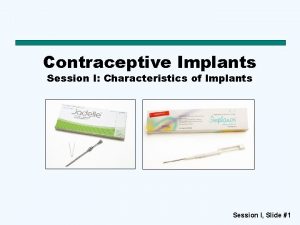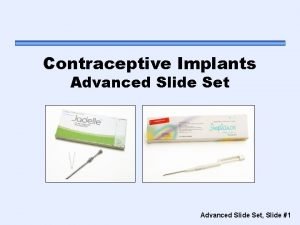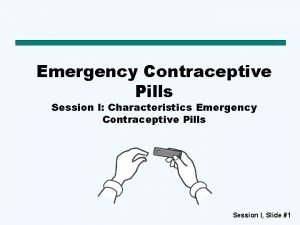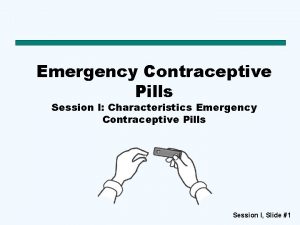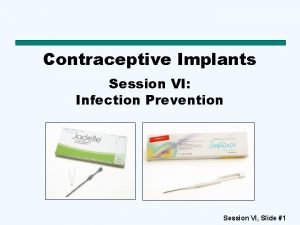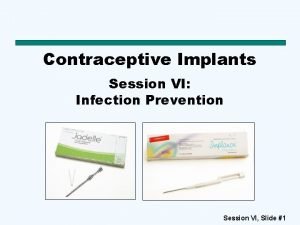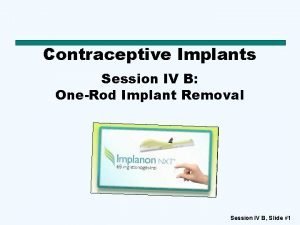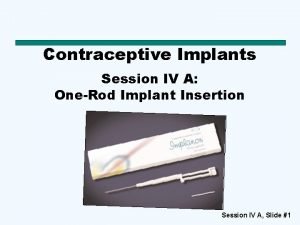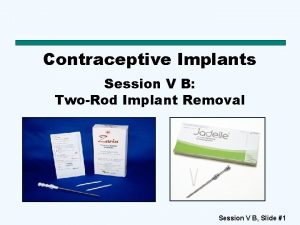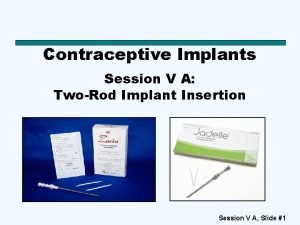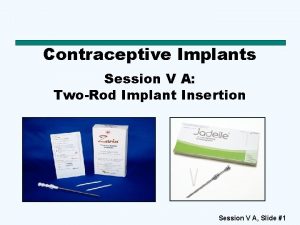Contraceptive Implants Session I Characteristics of Implants Adapted












- Slides: 12

Contraceptive Implants Session I: Characteristics of Implants Adapted by Dr Rodica Comendant, based on Training Resource Package for Family Planning: https: //www. fptraining. org/ Session I, Slide #1 1

What Are Implants? Progestin-filled rods (each about the size of a match stick) that are inserted under the skin – Jadelle: 2 -rod system, effective for 5 years – Sino-implant (II): 2 -rod system, effective for 4 years (possibly 5) – Implanon: 1 -rod system, effective for 3 years – Norplant: 6 -capsule system, effective for 5 years (possibly 7); no longer manufactured but some women are still using it Session I, Slide #2 2

Key Points for Providers and Clients What it is: – Small tubes placed under the skin of inner, upper arm. – Hormones from the tubes blocks sperm from reaching egg and prevents release of egg. How to use: – Specially trained provider inserts and removes implants. – Nothing to remember to do after insertion. What to expect: – Changes in monthly bleeding including irregular bleeding, spotting, heavier bleeding or no monthly bleeding, are common and safe. Important to remember: – Use another method if waiting for appointment. – Use condoms if you need protection from STIs or HIV/AIDS. Session I, Slide #3 3

Key Points for Clients • Safe to use • One of the most effective methods • Lasts for 3 to 5 years • Can be removed any time if you want to get pregnant Session I, Slide #4 4

Effectiveness of Implants In this progression of effectiveness, where would you place implants? More effective Male Sterilization Female Sterilization IUDs Implants Progestin-Only Injectables Combined Oral Contraceptives Male Condoms Standard Days Method Less effective Female Condoms Spermicides Session I, Slide #5 5

Relative Effectiveness of FP Methods Method # of unintended pregnancies among 1, 000 women in 1 st year of typical use No method 850 Withdrawal 220 Female condom 210 Male condom 180 Pill 90 Injectable 60 IUD (CU-T 380 A / LNG-IUS) Female sterilization 8/2 5 Vasectomy 1. 5 Implant 0. 5 Source: Trussell J. , Contraceptive Failure in the United States, Contraception 83 (2011) 397 - 404, Elsevier Inc. Session I, Slide #6 6

Implants: Mechanism of Action Implants work in two ways Suppresses hormones responsible for ovulation Thickens cervical mucus to block sperm Implants have no effect on an existing pregnancy. Session I, Slide #7 7

Implants: Characteristics • Very safe and 99. 95% effective • Easy to use • Fertility returns without delay when removed • Can be used by breastfeeding women • Offer health benefits Source: Hatcher, 2007; WHO, 2010; CCP and WHO, 2011. • Have side effects • Require minor surgery to insert and remove • Cannot be initiated and discontinued without provider’s help • Provide no protection from STIs/HIV Session I, Slide #8 8

Implants: Health Benefits • Reduced risk of symptomatic pelvic inflammatory disease (PID) • Reduced risk of iron-deficiency anemia • Reduced risk of ectopic pregnancy – 6 per 100, 000 in implant users – 650 per 100, 000 in women using no contraception Source: CCP and WHO, 2011; Task Force for Epidemiological Research on Reproductive Health, 1998. Session I, Slide #9 9

Possible Side Effects of Implants (part 1) Some users report changes in bleeding patterns: First several months: After about one year: • Lighter bleeding and fewer days of bleeding • Irregular bleeding • Infrequent bleeding • No monthly bleeding *Implanon users are more likely to have no monthly bleeding than irregular bleeding. How would you feel about these side-effects? Session IVA, Slide 10

Possible Side Effects of Implants (part 2) • Headaches • Lower abdominal pain • Acne (can improve or worsen) • Weight change • Breast tenderness • Dizziness • Mood changes • Nausea, nervousness Session I, Slide #11 11

Jadelle: Continuation Rates and Reasons for Discontinuation Cumulative Discontinuation Rate per 100 Women 30. 5 25. 9 24. 3 23. 4 0. 8 82. 7 Source: Sivin et al. , 1998. 66. 2 49. 5 36. 6 27. 4 Cumulative Continuation Rate per 100 Women Session I, Slide #12 12
